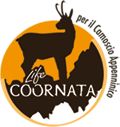The Gran Sasso and Monti della Laga National Park
The Gran Sasso National Park is situated in the central-south of the Apennines and extends into the Abruzzo, Latium and Marche regions. Human presence in the area is scarce (14,870 inhabitants) and mainly involves cow and sheep grazing (45%) and, to a lesser extent, forestry activities (20%) and cereal grain cultivation (5%). 30% of the area is marked for nature conservation. Moreover, walking and hiking are important activities in all the area. The land is mainly public, with a small part privately owned.
The Gran Sasso covers an area of high environmental value, with a wide variety of habitats and many important and interesting species of animals and plants. The northern part of the park (Monti della Laga) is mainly covered in forest and grazing areas on marly-renaceous land. Instead, the southern part (Gran Sasso) mainly consists of rocky limestone outcrops, glacial formations and alpine meadows. From 300 m. to more than 2,900 m. above sea level, we find a wide variety of vegetation, including ilex groves, mixed oaks groves, deciduous mesophyll forests of linden and oak, Fagus sylvatica forests (very widespread), chestnut, interesting relict groves of Abies alba and subalpine meadows and grazing pastures. The abundance of flora in the area is very rich with more than 2,400 species, including various native species found in high altitude pastures and limestone scree, such as Viola magellensis, Goniolimon italicum and Adonis distorta. The most important fauna species are Rupicapra pyrenaica ornata, Canis lupus, Vipera Ursinii and Chionomys nivalis. There are also 6 nesting pairs of Aquila chrysaetos and more than 300 pairs of Pyrrhocorax pyrrhocorax, and, in recent years, the area has been frequented and used as a feeding ground for specimens of Gyps fulvus, originating from the nearby nesting colony Sirente Velino Regional Park.
The Gran Sasso Park, together with other adjoining protected areas, included in Latium, Marche and Abruzzo (Majella National Park and Abruzzo National Park), is the Apennine area that hosts an estimated population of 300-320 Rupicapra pyrenaica ornata (2008). The continual expansion of the areale and the increase in numbers make it possible to remove specimens and reintroduce them into new areas.
